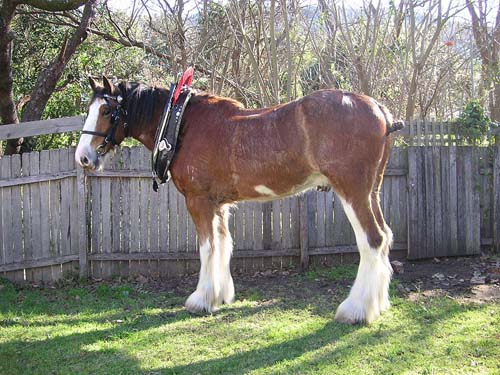
The Clydesdale horse is one of the most easily recognizable horse breeds in the world. These horses have a huge built and can weigh up to 2000 pounds. These horses grow up to 16 - 17 hands high and have a strong chest and beautifully well defined bone structure. They have feather like structures around their hooves which enables us to identify this breed easily. This strong animal is also very graceful. The way it trots forward talks a lot about the grace of this animal. It lifts the foot daintily and places it forward taking a long stride. They eyes of the Clydesdale horse which are dark and large, reflect the intelligence of this animal. These horses are found predominantly in Scotland and can survive the harsh weather in that place thanks for the feathers in their legs and a heavy coat with a thick mane. The underbelly of this horse is generally white in color and their hooves are striped in black and white. The muzzle of the Clydesdale horse is generally covered in white with the region of the chin and lips having black spots.
Size
16 - 17 hands
Colours
Brown, Black, Chestnut and Bay
Suitable for
In the 17th century these animals were used as warhorses. The Clydesdale Horse was also used to pull carriages and other farm equipment. With the passage of years, they were also used to pull milk and vegetable carts and also other heavy equipments for industrial purposes. They also find their uses in various logging operations. They also contributed to the promotion and advertising campaigns for a few companies. Today, the Clydesdale horse is also used in the Royal Cavalry Band in London to carry a silver kettle which weighs 90 pounds. They are also used as exhibits during various shows and competitions.
History
These horses have a history of about 300 years. They came into existence in the 18th century, thanks to the cross breeding between the local mares and other English and Flemish breeds. The horses that were born had a thick coat and mane and feathers on their legs which helped them adapt to the cold climate in Scotland. The immense strength that this breed possessed and the versatility they displayed made them the favorite of people. These horses were used as warhorses and as animals to draw heavy loads. Due to this benefit, their popularity spread to various countries and they were exported to England, New Zealand, South American, Austria, Italy and Russia.
:max_bytes(150000):strip_icc():format(webp)/what-horses-eat-that-keep-them-healthy-1886504-FINAL-5ba8dd3746e0fb0025eb2cb4.png)
:max_bytes(150000):strip_icc():format(webp)/horse-eye-resized-56a4dbf03df78cf77284fe95.jpg)
:max_bytes(150000):strip_icc():format(webp)/Horse-grooming-GettyImages-495726400-5876f27d5f9b584db351222e.jpg)
:max_bytes(150000):strip_icc():format(webp)/close-up-of-hand-holding-parrot-705172843-5b52bc4ec9e77c0037b6e5a4.jpg)
:max_bytes(150000):strip_icc():format(webp)/GettyImages-579524112-5c77331146e0fb000140a3a6.jpg)
:max_bytes(150000):strip_icc():format(webp)/budgerigarsonrope-331834_1920-5b628213c9e77c00255b32bc.jpg)
:max_bytes(150000):strip_icc():format(webp)/GettyImages-106887241-58325bc03df78c6f6a9a2ed2.jpg)
:max_bytes(150000):strip_icc():format(webp)/GettyImages-878015800-06106157c9d34a2081db4abcae8699b1.jpg)
:max_bytes(150000):strip_icc():format(webp)/hungry-cat-57b72fac5f9b58cdfda11a62.jpg)


:max_bytes(150000):strip_icc():format(webp)/4374985466_59c7f6545b_o-8b4f24f2f3e544349fe537fde58cfad0.jpg)
:max_bytes(150000):strip_icc():format(webp)/GettyImages-9298737261-500c5a2fba4248f89d1c17a33bf438f7.jpg)
:max_bytes(150000):strip_icc():format(webp)/veterinarian-and-owners-examining-dog-in-vet-s-surgery-164853745-dbecbdb691d549d79487d84356920cf4.jpg)